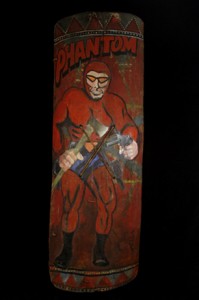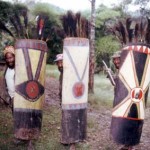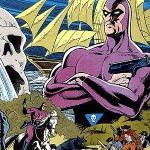 A few days ago, while idly surfing the net, I stumbled upon a photograph that seemed to come from another world, a place much more surreal and interesting than the one I inhabit. The photo in question showed a traditional fighting shield from highlands of Papua New Guinea. But it wasn’t the shield that caught my attention. It was the artwork. The maker had painted the Phantom on it, a comic-strip character created in the 1930s by American artist Lee Falk. And the superhero on the shield clearly meant business. He held an axe in one hand, a revolver in the other.
A few days ago, while idly surfing the net, I stumbled upon a photograph that seemed to come from another world, a place much more surreal and interesting than the one I inhabit. The photo in question showed a traditional fighting shield from highlands of Papua New Guinea. But it wasn’t the shield that caught my attention. It was the artwork. The maker had painted the Phantom on it, a comic-strip character created in the 1930s by American artist Lee Falk. And the superhero on the shield clearly meant business. He held an axe in one hand, a revolver in the other.
The idea of the Phantom fighting off evil in Papua New Guinea fascinated me, so I began digging around, trying to piece together the anthropological backstory. I was pretty certain there was one.
And I was right.
This Phantom Shield and others much like it belonged to the Wahgi people, inhabitants of Papua New Guinea’s remote interior. Isolated from the modern world until 1933, the Wahgi had long taken part in the region’s endemic warfare–the violent feuding that flared up across the highlands.
 When the first Europeans entered Wahgi territory in 1933, they saw men brandishing huge, feather-adorned wooden shields. Split from tree trunks, the shields were so heavy that some Wahgi men said they needed help from ancestral spirits just to carry them into battle. It wasn’t long, however, before Europeans started shipping guns into the area and the Wahgi realized to their rue that a wooden shield was no match for bullets.
When the first Europeans entered Wahgi territory in 1933, they saw men brandishing huge, feather-adorned wooden shields. Split from tree trunks, the shields were so heavy that some Wahgi men said they needed help from ancestral spirits just to carry them into battle. It wasn’t long, however, before Europeans started shipping guns into the area and the Wahgi realized to their rue that a wooden shield was no match for bullets.
But the Wahgi liked their shields. So they did something wonderful. They began turned them into works of ritual art. And while casting about for new designs for this new kind of shield, some Wahgi men lit upon the colorful comic books that American servicemen tucked into their kitbags during the Second World War.
 The Phantom particularly delighted the Wahgi. He came from a fictional African country blessed with jungle, rather like New Guinea. He was extremely good with weapons and wore a mask, just like they did during rituals. Best of all, he descended from a long, ancestral line of crime-fighters, a huge plus for a culture that practiced ancestor worship.
The Phantom particularly delighted the Wahgi. He came from a fictional African country blessed with jungle, rather like New Guinea. He was extremely good with weapons and wore a mask, just like they did during rituals. Best of all, he descended from a long, ancestral line of crime-fighters, a huge plus for a culture that practiced ancestor worship.
An excellent fighting man, the Phantom was often called “The Man Who Cannot Die.” I don’t think the Wahgi were ever primitive in any sense of the word. Like comic-book readers everywhere, they knew powerful magic when they saw it.
Upper Photo: Phantom Shield from New Guinea, ca 1960s-1980s. Courtesy The Calvin Morris Gallery
Middle Photo: Wahgi war shields. Courtesy Australian National University
Lower Photo: Promotional Art for DC Comics The Phantom, vol 1, by Joe Orlando and Dave Gibbons.
Fascinating. Thanks for posting–I really enjoyed this story.
Thanks for the kind words, Casey! I’m honored.